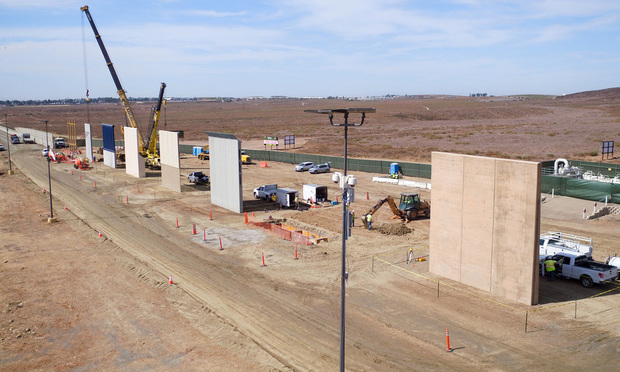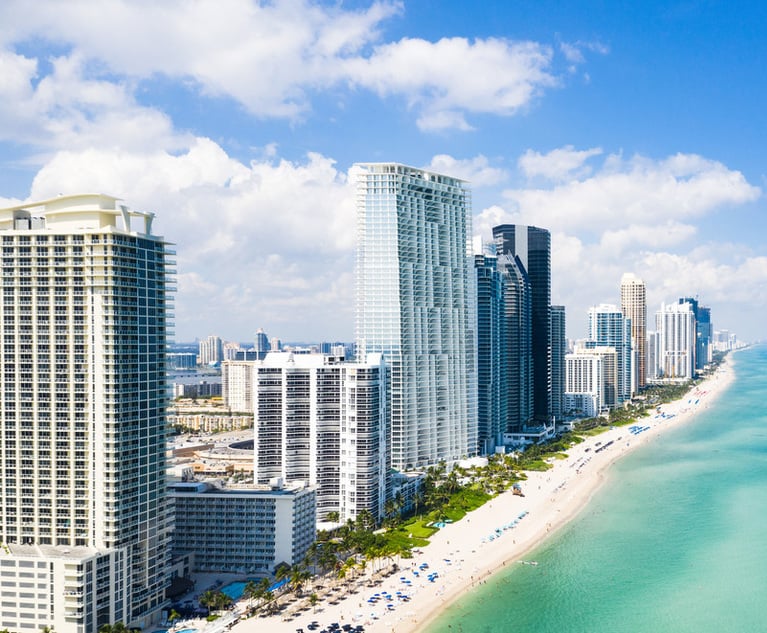US Prepares to Start Building Portion of Texas Border Wall
Congress last March approved more than $600 million for 33 miles of new barriers in the Rio Grande Valley.
February 05, 2019 at 10:49 AM
4 minute read
 Mexico-U.S. border wall prototypes/photo by CBP Photography/Flickr
Mexico-U.S. border wall prototypes/photo by CBP Photography/Flickr
The U.S. government is preparing to begin construction of more border walls and fencing in South Texas' Rio Grande Valley, likely on federally owned land set aside as wildlife refuge property.
Heavy construction equipment was expected to arrive starting Monday, U.S. Customs and Border Protection said. A photo posted by the nonprofit National Butterfly Center shows an excavator parked next to its property.
Congress last March approved more than $600 million for 33 miles of new barriers in the Rio Grande Valley. While President Donald Trump and top Democrats remain in a standoff over Trump's demand for $5.7 billion in border wall funding, U.S. Customs and Border Protection has pushed ahead with building what's already funded.
That construction was often described as fencing, and the government funding bill that included construction was supported by some Democrats in the House and Senate. CBP refers to what it plans to build as a “border wall system.”
According to designs it released in September, CBP intends to build 25 miles of concrete walls to the height of the existing flood-control levee in Hidalgo County next to the Rio Grande, the river that forms the U.S.-Mexico border in Texas. On top of the concrete walls, CBP will install 18-foot steel posts and clear a 150-foot enforcement zone in front.
Maps released by CBP show construction would cut through the butterfly center, a nearby state park, and a century-old Catholic chapel next to the river.
Many landowners oppose a border wall and have vowed to fight the U.S. government if it tries to seize their property through eminent domain. Court fights over condemning land could take weeks if not months.
CBP said in its statement that it intends to start construction on federally owned land. Environmental advocates expect the government to use land that's part of the Lower Rio Grande Valley National Wildlife Refuge.
The refuge consists of dozens of parcels of land purchased over the last 40 years to create a corridor for endangered species and other wildlife.
The Department of Homeland Security can waive environmental restrictions to construct a border wall and issued its waiver for Hidalgo County in October. A coalition of environmental groups has sued DHS over its use of waivers, arguing that wall construction would endanger ocelots, rare birds and other wildlife that rely on refuge land for habitat. That lawsuit is still pending.
Congress last March required CBP not to build in the Santa Ana National Wildlife Refuge after a public outcry. But it didn't exempt the Lower Rio Grande Valley refuge.
“Santa Ana was not a big enough refuge to sustain all the wildlife down here,” said Jim Chapman, a longtime resident of the Rio Grande Valley and member of the group Friends of the Wildlife Corridor.
The National Butterfly Center released the text of an email sent by an attorney from the U.S. Department of Justice. The lawyer, Cliff Stevens, says in the email that construction will begin in mid-February “on federally owned land east of Bentsen State Park.”
Directly east of Bentsen State Park is a refuge tract called El Morillo Banco, which is between the state park and the butterfly center. DOJ declined to comment on the email, and CBP did not respond to several requests for comment.
Land already in the hands of the government becomes an easier place to start construction quickly, said U.S. Rep. Henry Cuellar, D-Laredo. Cuellar has introduced a proposal that would instruct CBP not to build border walls in several places that have environmental and cultural significance.
“The easiest way, historically, is to go to public lands, because who's going to fight them?” he said.
Protesters were walking Monday along the river levee where CBP intends to start construction. The butterfly center said on Facebook that a local police officer had declared all their property south of the levee to be off limits. The center says it intends to take legal action.
Chapman said that despite months of protests and meetings, he hadn't seen “any attempt” from the U.S. government “to acknowledge and to take the needs of wildlife into account.”
“If you were going to design a border wall with maximal impact, you would do exactly what they were doing,” Chapman said. “You couldn't do it worse.”
Nomaan Merchant reports for the Associated Press.
This content has been archived. It is available through our partners, LexisNexis® and Bloomberg Law.
To view this content, please continue to their sites.
Not a Lexis Subscriber?
Subscribe Now
Not a Bloomberg Law Subscriber?
Subscribe Now
NOT FOR REPRINT
© 2025 ALM Global, LLC, All Rights Reserved. Request academic re-use from www.copyright.com. All other uses, submit a request to [email protected]. For more information visit Asset & Logo Licensing.
You Might Like
View All
Winston & Strawn Snags Sidley Austin Cross-Border Transactions Partner in Miami
2 minute read
Miami’s Arbitration Week Aims To Cement City’s Status as Dispute Destination
3 minute read
Brazil Is Quickly Becoming a Vital LatAm Market for Greenberg Traurig, Other US Law Firms
5 minute readTrending Stories
- 1South Carolina Physicians Challenge Abortion Ban Under Religious Freedom Claims
- 2Special Series Part 5: The State’s Bond Lock Impermissibly Delegates Legislative Authority
- 3President-Elect Donald Trump Sentenced to Unconditional Discharge
- 4JCPenney Customer's Slip-and-Fall From Bodily Substance Suit Best Left for a Jury to Decide, Judge Rules
- 5Products Liability: The Absence of Other Similar Claims—a Defense or a Misleading Effort to Sway a Jury?
Who Got The Work
Michael G. Bongiorno, Andrew Scott Dulberg and Elizabeth E. Driscoll from Wilmer Cutler Pickering Hale and Dorr have stepped in to represent Symbotic Inc., an A.I.-enabled technology platform that focuses on increasing supply chain efficiency, and other defendants in a pending shareholder derivative lawsuit. The case, filed Oct. 2 in Massachusetts District Court by the Brown Law Firm on behalf of Stephen Austen, accuses certain officers and directors of misleading investors in regard to Symbotic's potential for margin growth by failing to disclose that the company was not equipped to timely deploy its systems or manage expenses through project delays. The case, assigned to U.S. District Judge Nathaniel M. Gorton, is 1:24-cv-12522, Austen v. Cohen et al.
Who Got The Work
Edmund Polubinski and Marie Killmond of Davis Polk & Wardwell have entered appearances for data platform software development company MongoDB and other defendants in a pending shareholder derivative lawsuit. The action, filed Oct. 7 in New York Southern District Court by the Brown Law Firm, accuses the company's directors and/or officers of falsely expressing confidence in the company’s restructuring of its sales incentive plan and downplaying the severity of decreases in its upfront commitments. The case is 1:24-cv-07594, Roy v. Ittycheria et al.
Who Got The Work
Amy O. Bruchs and Kurt F. Ellison of Michael Best & Friedrich have entered appearances for Epic Systems Corp. in a pending employment discrimination lawsuit. The suit was filed Sept. 7 in Wisconsin Western District Court by Levine Eisberner LLC and Siri & Glimstad on behalf of a project manager who claims that he was wrongfully terminated after applying for a religious exemption to the defendant's COVID-19 vaccine mandate. The case, assigned to U.S. Magistrate Judge Anita Marie Boor, is 3:24-cv-00630, Secker, Nathan v. Epic Systems Corporation.
Who Got The Work
David X. Sullivan, Thomas J. Finn and Gregory A. Hall from McCarter & English have entered appearances for Sunrun Installation Services in a pending civil rights lawsuit. The complaint was filed Sept. 4 in Connecticut District Court by attorney Robert M. Berke on behalf of former employee George Edward Steins, who was arrested and charged with employing an unregistered home improvement salesperson. The complaint alleges that had Sunrun informed the Connecticut Department of Consumer Protection that the plaintiff's employment had ended in 2017 and that he no longer held Sunrun's home improvement contractor license, he would not have been hit with charges, which were dismissed in May 2024. The case, assigned to U.S. District Judge Jeffrey A. Meyer, is 3:24-cv-01423, Steins v. Sunrun, Inc. et al.
Who Got The Work
Greenberg Traurig shareholder Joshua L. Raskin has entered an appearance for boohoo.com UK Ltd. in a pending patent infringement lawsuit. The suit, filed Sept. 3 in Texas Eastern District Court by Rozier Hardt McDonough on behalf of Alto Dynamics, asserts five patents related to an online shopping platform. The case, assigned to U.S. District Judge Rodney Gilstrap, is 2:24-cv-00719, Alto Dynamics, LLC v. boohoo.com UK Limited.
Featured Firms
Law Offices of Gary Martin Hays & Associates, P.C.
(470) 294-1674
Law Offices of Mark E. Salomone
(857) 444-6468
Smith & Hassler
(713) 739-1250







